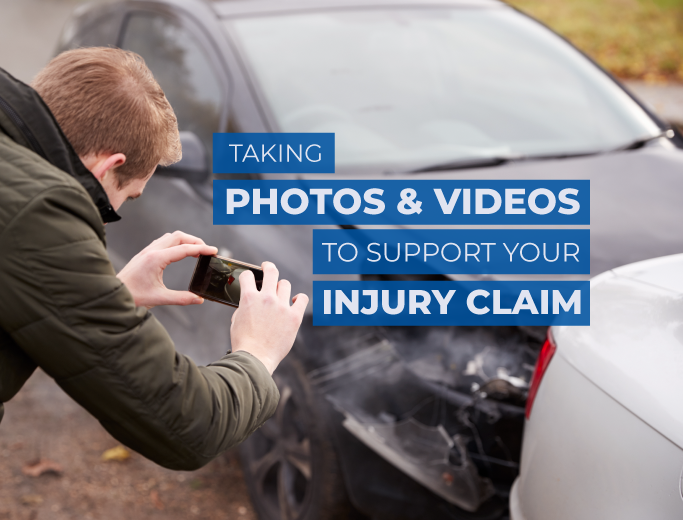-

As the saying goes, “a picture is worth a thousand words”. This is especially true for personal injury claims. Photos and videos of the aftermath of a car wreck capture critical evidence, and they often prove to be incredibly valuable to personal injury cases. In the chaos following a collision, taking photos and videos may not be at the top of your mind; however, this documentation is incredibly important when proving fault and demonstrating the extent of your injuries. Below we discuss the most important items you or any passengers injured in the crash should document following a car crash, as well as tips for ensuring the photos and videos you take are as effective as possible in supporting your injury claim.
THE ACCIDENT SCENE
After checking yourself and others for serious injury, begin capturing photos and videos of the scene. If you’re hurt and unable to take photos or videos, try to find a witness who can. Make sure you take a variety of images, including:
- Wide-angle shots that capture the entire scene
- All vehicles involved in the collision, and how they’re positioned following the crash.
- It’s also a good idea to take images of license plates, registrations, and insurance information of the other individuals involved in the wreck, just in case this information gets lost in the chaos.
Focus on showing the whole picture, such as where the wreck occurred, the time of day, weather, traffic signs, or any other significant factors that may have contributed to the accident. If there are signs of negligence, such as a vehicle defect or a hazard in the road, take photos and videos of this as well. This documentation will provide critical context about how and why the accident occurred.
YOUR INJURIES
Begin documenting your injuries as soon as possible following a wreck. This includes:
- Cuts, bruises, fractures, or any other visible wounds.
- As you recover from the wreck, continue photographing the progress of your injuries or any complications that may arise.
- If you require any medical devices following the wreck, such as a cast, a wheelchair, a neck brace, or any other medical instruments, take photos of them as well.
It is important to also understand that not all injuries are visible. Traumatic brain injuries, whiplash, and neck and back injuries may not be as easy to document in photos and videos as a broken bone would be. That’s where diagnoses and regular treatment with a healthcare provider can assist with getting your injuries documented and contained in medical records (x-rays, CT scans, etc.). All of these elements combined can help you and your legal team establish a timeline with verifiable proof about how the accident has impacted you.
THE DAMAGE
While property damage doesn’t always tell the full story of a personal injury claim, documenting any damage to your vehicle is still a necessary step following a collision.
- Take pictures from different angles showing your entire vehicle: capture any dents, dings, scratches, debris, parts that are missing or destroyed, and any other visible damage.
- If possible, taking images of the other vehicles involved in the wreck is highly encouraged.
- Serious accidents can also cause the belongings you had in the car to be scattered across the road – documenting any of your personal items that are destroyed or damaged along with your vehicle could be valuable in your personal injury claim.
TAKING CLEAR PHOTOS AND VIDEOS FOR YOUR CLAIM
You don’t need to be a professional photographer or videographer to document your personal injury claim – typically, a cell phone is all you need. However, blurry, dark, or unclear photos or videos won’t do much to strengthen your case. To get the best evidence possible:
- Hold your camera steady when taking photos or video. Brace your arm against something sturdy, like a tree or a guardrail, to keep your hands and camera stable.
- Make sure you have plenty of light; use your phone’s flash if necessary.
- Some smartphones have the ability to store important information, such as timestamps and location data, within your photos and videos. This information, while not necessary, is helpful when determining specific details about your case that you may have trouble recalling later on.
- Turn on your location data for photos and videos within your settings if possible.
- Finally, take as many photos and videos as necessary to capture all of the details.
Phones have lots of storage these days, and having more photos and videos of your wreck is better than having too few. If you’re unsure if a photo or video contains helpful information about the collision, our team is highly skilled at analyzing documentation from accident scenes. We can review your pictures or footage and determine if they can be used to strengthen your case.
GET IT DONE
If you’ve been hurt due to someone else’s negligence, documenting to incident can prove valuable when filing a personal injury claim. However, collecting photos and videos on your own may be challenging. Our car accident lawyers have the experience and can work alongside you to gather evidence so that you can focus on the healing process. We have team members who can visit the accident scene, take photos and videos of damage, obtain medical records, and more. Get Hughes & Coleman and Get It Done – call us today at 800-800-4600 for a free case evaluation.
Get In Touch Today!
We offer free consultations 24/7 and there will always be someone here to take your call. Call our personal injury lawyers today for a free consultation or fill out this form and we will contact you.
We serve clients across Tennessee and Kentucky and we have several offices throughout both states. See all of our locations and contact us today.


